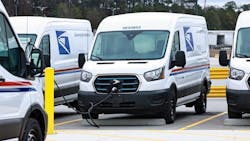US Postal Service Installing 14,000 EV Charging Stations and Deploying 21,000 EVs to Decarbonize Delivery Services
The United States Postal Service (USPS) has unveiled its first set of electric vehicle charging stations at its South Atlanta Sorting and Delivery Center (S&DC). The USPS will install more of these charging stations at hundreds of new S&DCs nationwide throughout 2024 to power what the USPS says will be the nation’s largest EV fleet.
The electrification and modernization of the Postal Service’s delivery fleet is part of the organization’s $40 billion investment strategy to upgrade and improve USPS processing, transportation, and delivery networks.
“The improvements we need to achieve in sustainability are an integral outgrowth of the broader modernization efforts we have undertaken through our 10-year Delivering for America plan,” said Postmaster General Louis DeJoy. “As we transform our operating processes and invest in new automation, new technologies, and upgraded facilities and vehicles, we will generate significant efficiencies that reduce our costs, slash our carbon footprint, and minimize waste.”
As part of its 10-year Delivering for America (DFA) plan, the Postal Service expects to convert approximately 400 selected sites into S&DCs across the US. These centers – providing faster and more reliable mail and package delivery over a greater geographical area – will serve as the local hubs to deploy EVs along local carrier routes.
As of January 2024, the USPS has opened 29 S&DCs.
To accompany these S&DCs, the Postal Service will add nearly 14,000 EV chargers to efficiently charge its EVs overnight prior to the next day’s deliveries. The chargers will be manufactured by three suppliers – Siemens, ChargePoint, and Blink.
The USPS will also procure a total of 21,000 COTS EVs – including 9,250 manufactured by the Ford Motor Company. In addition, the Postal Service anticipates adding at least 45,000 battery-electric Next Generation Delivery Vehicles by 2028, bringing the total number of EVs in its delivery fleet to more than 66,000.
“In every neighborhood in America, people know their postal carrier and recognize the USPS vehicle driving down the street,” said John Podesta, Senior Advisor to the President for Clean Energy Innovation and Implementation. “The work USPS is doing to electrify those vehicles is making EVs commonplace on every road and street in our country, while reducing air pollution and increasing comfort and safety for the dedicated public servants who deliver our mail.”
About the Author
Breanna Sandridge, Senior Editor
Breanna Sandridge is senior editor for EnergyTech and Microgrid Knowledge, both part of the energy group at Endeavor Business Media.
Prior to that, Breanna was managing editor for Machinery Lubrication and Reliable Plant magazines, both part of Noria Corp. She has two years experience covering the industrial sector.
She also is a 2021 graduate of Northeastern State University (Oklahoma) with a Bachelor's in English.
